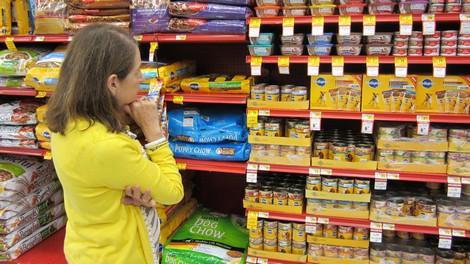How To Read a Pet Food Label
posted: Mar. 25, 2019.

Ensuring good nutrition for your pet means understanding what he is eating.
Every time you visit your local pet store to restock your cat’s or dog’s food supply, it seems that a dozen new products have hit the shelves - all of which claim to be the best, most nutritious and healthiest formula to ever exist. How do you know whether you’re feeding your pet the equivalent of cheese fries for breakfast or kibble that provides the nutritional value he needs to live a long, healthy life?
By working with your veterinarian and learning about some of the key phrases used on pet food packaging, it is possible to find a diet that meets the nutritional needs of your furry family member. Use this handout as a guide to choose a food your pet will love and you can feel good about.
PRODUCT NAME
A pet food product’s name (such as Adult Roasted chicken, rice & Vegetable Flavor Dry Dog Food), not be be confused with it’s brand name (Pedigree), provides the initial insight into its quality. Pet food companies market their products with enticing terms such as “dinner” and “flavor” but a savvy pet owner can learn hot to spot the phrases that matter most.
The term “chicken” used alone in a product’s name means that chicken makes up at least 95 percent of the total weight of the product, not counting the water used for processing. Counting the added water, chicken must comprise 70 percent of the product. However, when the “chicken” is accompanied by “dinner”, “entree” or “platter”, only 10 percent of the entire product needs to be chicken. A product whose name includes “with chicken” is required to have only 3 percent chicken, and “chicken flavor” can be used on labels where very little chicken is used and only then to add flavor. For example, a product called “tuna cat food” must contain at least 70 percent tuna, but a can of “tuna dinner” is only required to contain 10 percent tuna.
INGREDIENT LIST
The list on a pet food label does not indicate the quality of each ingredient, but learning how to read the list can help you make sure your pet is receiving the proper nutrients. Pet food ingredients must be listed in descending weight order, but there are some loopholes. For instance, items that contain large amounts of moisture, such as beef, poultry or fish, are likely to be listed first. Water content comes into play specifically when looking at dry foods. In these products, ingredients farther down the list may offer more protein but may weigh less because the moisture has been removed.
Another important word on the ingredient list is “by-product”. Pet food ingredients labeled as such are not as harmful as some advertisements might portray. By-products can include highly digestible and nutritious organs. Additionally, some filler items, such as corn, rice and potatoes can be listed separately to give the illusion that less of the product exists in the total formula. For example, by breaking down corn into individual types - flaked corn, ground corn, screened corn, kibbled corn - each type appears lower on the list.
GUARANTEED ANALYSIS
To meet regulations set by the Association of American Feed Control Officials (AAFCO) - an independent organization that regulates the sale and distribution of pet food - manufacturers must list the minimum amount of protein and fat and the maximum amount of fiber and moisture as percentages of the product. This is called the guaranteed analysis.
In cat foods, the maximum percentage of ash (the mineral component) is often guaranteed, as are the percentages of taurine and magnesium. For dog foods, minimum percentage levels of calcium, phosphorus, sodium and linoleic acid are found in some products.
Because moisture content can skew the percentages significantly, an accurate comparison of the guaranteed analysis of two pet foods is possible when they are converted a moisture-free or dry-matter basis. This would come into play especially when comparing the guaranteed analyses of dry and canned dog food. To distinguish the nutritional value accurately, the moisture content must be taken into consideration.
STATEMENT OF NUTRITIONAL ADEQUACY
Products labeled as “complete and balanced” must contain a nutritional adequacy statement indicating that the food contains the minimum amount of all the nutrients the intended animal requires. Determining nutritional sufficiency is done one of two ways:
-
The product, or the lead member of a family of products, is tested on live animals using AAFCO trial protocols and found to provide adequate nutrition. This is the gold standard for determining nutritional adequacy. Products tested in this way include the following label wording: “Animal feeding tests using AAFCO procedures substantiate that [product name] provides complete and balanced nutrition.”
-
Rather than testing the food on animals, it’s ingredients are formulated to meet the requirements of a specific nutrient profile established by the AAFCO. With this method, there is no guarantee of nutrient bioavailability or palatability. These product labels should include the following statement: “[Product name] is formulated to meet the nutritional levels established by the AAFCO [Dog/Cat] Food Nutrient Profiles.”
If a food has no met either of the above standards - and is not clearly identified as a treat, snack or supplement - the label must read: “This product is intended for intermittent or supplemental feeding only.”
The nutritional adequacy statement also provides details about the life stage(s) for which the product is most suitable. For example, a food labeled for a senior dog must meet the requirements for adult maintenance and thus should not be fed to a puppy, because it may not have been tested to meet the standards for puppies. Products labeled “for all life stages” meet the more stringent nutritional needs for growth and reproduction.